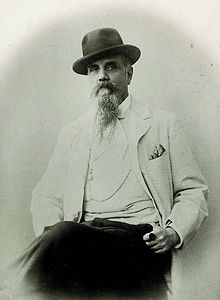Guglielmo Calderini
Guglielmo Calderini (born March 3, 1837 in Perugia , Umbria , † February 12, 1916 in Rome ) was an Italian architect and an important exponent of eclecticism .
Live and act
Calderini studied at the Academy in Perugia, the University of Turin and in Rome , where he obtained an architectural diploma. He then returned to his hometown Perugia as a town architect (until 1869), where he taught architecture and art history from 1868 to 1882 at the Pietro Vannucci Art Academy . Since 1869 he was also employed as an honorary engineer for the Royal Ministry of Public Works and received orders from municipal building authorities from all over Italy, the Lazio Monument Office and the building works of the Ostiense Basilica in Rome. He continued his teaching activities from 1881 as a professor of decoration and architecture at the University of Pisa and finally taught from 1891 to 1912 at the prestigious Royal Engineering College Scuola Superiore di Ingegneria in Rome. Calderini won many tenders and competitions and created numerous representative public buildings in Italy. Calderini was also involved in the preservation of monuments and archeology . In 1898 he was appointed chief curator of the monument commission in his hometown of Perugia.

In 1884 his design won the competition for the construction of a Roman palace of justice announced in 1882 by the Italian Minister of Justice, Giuseppe Zanardelli . Calderini combined architectural elements from the late Renaissance and Baroque periods for the extremely magnificent courthouse, which was intended to celebrate the founding of the Italian national state in 1870 . In many metropolises in Europe, similar monumental judicial buildings conceptually based on the model of the Parisian Palais de Justice were built (e.g. Brussels , Vienna , Munich , Cologne ).
Due to serious foundation problems , statics errors and archaeological excavations on the site in the meantime, the construction of the building, which was built between 1888 and 1910 and which went down in history as Calderini's main work, was delayed and Calderini had to make several significant changes to his original plans. Because of its monumentality, escalating construction costs and the long construction period, the project was not without controversy. The result was disparagingly called Palazzaccio ("ugly showy palace") by the Romans . Desperate about the public hostility to his work and unanswered questions about the financing of the building, Guglielmo Calderini killed himself a few weeks before his 79th birthday. He found his final resting place in Rome. In addition to his buildings, he left behind numerous plans, drawings and watercolors of unrealized projects. Calderini's design works, such as street lamps and promenade decorations, have survived to this day in public spaces.
Works (selection)

- Cattedrale dell'Assunta in Savona (cathedral facade, 1879)
- Palazzo Comunale (Town Hall) in Fabro
- Chiesa di San Costanzo and adjoining baths in Perugia (1882–1890)
- Caserma d'Artiglieria (artillery barracks) in Foligno
- Quadriportico (four-sided colonnade) at Saint Paul Outside the Walls in Rome (from 1893)
- Palazzo Cesaroni in Perugia (1897), used as a hotel until 1925
- Palazzo di Giustizia (Palace of Justice) in Rome (1887–1910)
- Palazzo Bianchi in Perugia (1888–1904)
- Palazzo Municipale (town hall) of Messina (reconstruction in 1910 after earthquake damage)
... Florence Cathedral (here under construction, around 1870)
Neo-Baroque facade of the Savona Cathedral
literature
- Fedora Boco, Giorgio Muratore (ed.): Guglielmo Calderini. La construzione di un'architettura nel progetto di una capitale. Atti del convegno, Roma, Palazzo delle Esposizioni, 23 September 1995. Guerra, Perugia 1996, ISBN 88-7715-247-8 (on behalf of the Accademia di belle arti “Pietro Vannucci”).
- Fedora Boco et al. a. (Ed.): Guglielmo Calderini dai disegni dell'Accademia di belle arti di Perugia. Un architetto nell'Italia in construzione. Guerra, Perugia 1995, ISBN 88-7715-168-4 .
- Paolo Marconi (Ed.): Accademici di San Luca. Volume 1: Calderini. Editalia, Rome 1974.
- Giovanni B. Milani (Ed.): Le opere architettoniche di Guglielmo Calderini. Bestetti & Tumminelli, Milan 1917.
- Silvana Raffo Pani: CALDERINI, Guglielmo. In: Alberto M. Ghisalberti (Ed.): Dizionario Biografico degli Italiani (DBI). Volume 16: Caccianiga-Caluso. Istituto della Enciclopedia Italiana, Rome 1973.
- Luigi Càllari: Calderini, Guglielmo . In: Ulrich Thieme (Hrsg.): General Lexicon of Fine Artists from Antiquity to the Present . Founded by Ulrich Thieme and Felix Becker . tape 5 : Brewer-Carlingen . EA Seemann, Leipzig 1911, p. 383 ( Textarchiv - Internet Archive ).
Individual evidence
- ^ Soprintendenza Speciale per i Beni Archeologici di Roma (Roman Antiquities Administration): Guglielmo Calderini (1837–1916). ( Memento of the original from March 20, 2017 in the Internet Archive ) Info: The archive link was inserted automatically and has not yet been checked. Please check the original and archive link according to the instructions and then remove this notice. Short online biography in the Archaeological Data Archives project , accessed on March 18, 2017.
- ^ Sistema Archivistico Nazionale (National Archives System): Calderini, Guglielmo. Short biography in the Archivi degli architetti project , accessed on March 18, 2017.
- ↑ Bavarian State Ministry of Justice : 100 Years of the Munich Palace of Justice: 1897–1997 . (PDF), Munich 2004, pp. 6-7.
| personal data | |
|---|---|
| SURNAME | Calderini, Guglielmo |
| BRIEF DESCRIPTION | Italian architect |
| DATE OF BIRTH | March 3, 1837 |
| PLACE OF BIRTH | Perugia |
| DATE OF DEATH | February 12, 1916 |
| Place of death | Rome |







